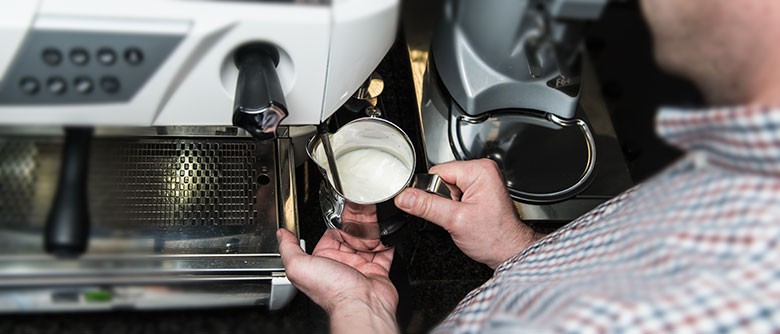How To Froth Milk
Learn how to turn milk into velvet. (Not literally of course.)
Overall, properly prepared milk for use in speciality drinks will always be foamed – even if you do not require any foam at all.
By introducing air into milk and heating it, the milk will automatically improve in both taste and texture.
Whether you use the foam that settles on top is a different matter entirely: for a cappuccino, you will be scooping it into the cup whilst on the other hand if it is a latte you’re whipping up then you’ll be more reserved when dishing the foam out.
Equipment
- Coffee machine with steam arm/wand
- Milk jug
- Milk
- Thermometer

Foaming milk
Top tip: Always use fresh, cold milk.
Pour the milk into a straight sided or belly jug. At a minimum, fill the jug a third of the way up and at most half fill it – the milk needs room to expand.
Purge the steam arm by turning it on for five seconds. This removes any standing water left in the arm and, it helps build the pressure up prior to use.
Position the tip of the steam wand just underneath the surface of the milk and turn the steam arm on to full power – no fairy steps here!
At this point, listen out to the sounds that are being made; if you hear a high-pitched, almost chirping, noise then you have hit the sweet spot. A splattering sound means you are too high, no sound at all means you are too low. Adjust accordingly.
As the milk froths, lower the jug to keep the tip of the wand just underneath the milk’s surface.
When your temperature gauge reads between 40-45°C, switch to texturing the milk.
Texturing milk
Raise the jug up a few centimetres and position it so that the steam wand is near to the jug’s side and below the milk’s surface.
Then, angle the jug slightly. This should cause a whirlpool-like effect inside the container that will break down bubbles and create denser, smoother foam.
When your thermometer reads 60°C turn the steam arm off. Typically, these devices have a slight delay in registering the heat, so the final temperature will read between 65-70°C, which is the sweet spot you should be aiming for.
Give the base of the jug a firm tap on the counter to break any surface bubbles and then clean the steam arm with a damp cloth. Do not touch it with your hand though as it will be piping hot!
Now you are ready to add the milk to the espresso.
Start by initially swirling the milk in the jug and keep swirling until all the foam is spread evenly throughout.
Step by Step Guide
- Pour cold milk into a jug
- Purge the steam wand by turning it on and off
- Place the tip of the steam arm just below the surface of the milk
- Turn the steam arm on to full power
- Listen out for a 'chirping' sound - You're on the right track!
- As the milk froths, lower the jug to keep the wand's tip submerged in liquid and not froth
- Heat to required temperature
- When finished, clean the steam arm
Watch
If you require a little more help, or just would like to see how the professionals do it, then check out our video below.
Paul Meikle-Janney, Head judge of the World Latte Art Championships, demonstrates the perfect milk foaming technique:
